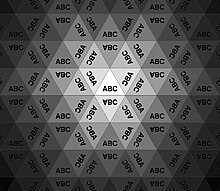kaleidoscope
The kaleidoscope is an optical device that is widely used as a children's toy .
The kaleidoscope was originally known to the ancient Greeks, but was not rediscovered until 1816 by the Scottish physicist David Brewster and a patent was applied for in 1817 . Brewster came across this while studying the polarization of birefringent crystals while looking at such crystals in a reflective metal tube.
etymology
The word kaleidoscope comes from the Greek and means: to see beautiful shapes . Specifically, the three words are: καλός kalós “beautiful”, εἴδος eidos “form, shape” and σκοπεῖν skopéin “look, see, contemplate”.
nature
A kaleidoscope is usually a 12 to 15 cm long tube with small, colored objects loosely inserted between a smooth and a frosted glass plate at one end. Often the objects are bodies made of colored glass . The other end of the kaleidoscope has a round window to look through. In the pipe itself there are three (sometimes four) mirror strips that touch each other on their long edges. The objects are reflected in it several times, so that a symmetrical colored pattern becomes visible that changes when turned.
There are also kaleidoscopes, which instead of glass plates have a container filled with a transparent liquid (mostly oil) in which all kinds of objects float. Due to the high viscosity of the liquid, the objects sink slowly downwards and change the pattern continuously, without having to constantly rotate.
Another form are open kaleidoscopes (also called teleidoscopes), which have a permanently installed lens instead of the glass plate with the objects. If you look through this, a section of the environment forms the pattern, which changes instead of rotating through horizontal and vertical movement.
Biggest kaleidoscope
The largest kaleidoscope in the world, the "Earth Tower" ( Japanese : 大地 の 塔 daichi no tō ), was on display during Expo 2005 in Japan. It was a 47 meter high tower, on whose spherical ceiling there was a play of colors with a diameter of more than 40 meters. The sunlight falling into the glass dome of the tower was reflected by a complicated arrangement of mirrors after multiple diversions onto three rotating glass panes. The constantly changing and merging symmetrical patterns typical of kaleidoscopes were created , which could be viewed from the entrance hall.
software
Kaleidoscopes can also be simulated on computers using software.
Other meanings
- Diverse, varied things are often metaphorically referred to as a kaleidoscope.
- The Beatles song " Lucy in the Sky with Diamonds " is about a "girl with kaleidoscope eyes".
- The literary work “Kaleidoscope of Everyday Life” by the Swiss aphorist Charles Tschopp makes use of this metaphor, whether it is the multicolor of human life.
- Physical principles are described in the articles Geometric Optics and Law of Reflection .
See also
literature
- Hannelore Dittmar-Ilgen: Why do soap bubbles burst? Physics for the curious. 4th revised edition. S. Hirzel Verlag, Stuttgart et al. 2003, ISBN 3-7776-1149-2 , p. 139: On the physics of kaleidoscopes and corner mirrors.
Individual evidence
- ↑ Colorful patterns in record size. The world's largest kaleidoscope is at the World Expo 2005 ( Memento from April 18, 2005 in the Internet Archive )
- ↑ Make Your Own Kaleidoscope! (Online simulator), krazydad.com



